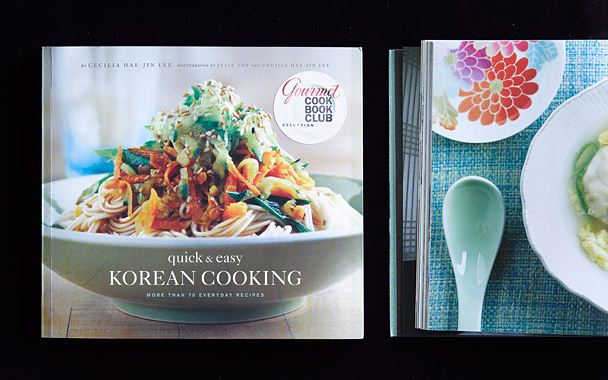When I phoned Cecilia Hae-Jin Lee about her striking new book—Quick & Easy Korean Cooking (Chronicle Books; 70 recipes; $22.95)—I wasn’t surprised to find her at home in Los Angeles, working in her garden. Her first book, a culinary memoir filled with stories from her Korean and American childhood, recounts her family’s passion for growing their own vegetables, using seeds sent from Korea, in order to provide for their cooking needs. Today, Lee says, she gardens strictly for pleasure because all the ingredients she wants can be found easily. Indeed, even the most exotic items (octopus, soybean sprouts, wakame, dried red dates, perilla leaves, rice flour) are available at Asian markets, and these markets are almost everywhere.
Yet for all the Korean pantry’s accessibility, there’s still the fear that the meals are elaborate banquets. It’s true, Lee explains, that feasts are part of the culture, but an everyday meal usually consists of rice, soup (such as her delicious seaweed and stir-fried beef broth), kimchi, and either a main attraction like spicy sliced pork or a sampling of small, simple dishes like seasoned tofu and sautéed. Without losing any of the flavor, Lee retools these traditional recipes so that their active prep time is no longer than 30 minutes. Take the Seasoned Fried Chicken. When I told Lee I was astonished that it called for a cup of cornstarch, she chuckled. “You’ve discovered the secret ingredient. It keeps the outside light and crunchy.” When I questioned the use of ketchup, again there was a knowing laugh before she admitted that Koreans are quick to assimilate compelling flavors: Ketchup has been in their pantry for a long time. Sweet, sour, tender, and crunchy, these are chicken nuggets with attitude—and minimal fuss. Lee even gave me permission to marinate the chicken overnight and to make the sauce the night before, too, which means dinner tomorrow will be on the table as soon as the rice is done.
Food in Five
Korea is characterized by a complex social structure, an elaborate system of etiquette, and a distinctive cuisine. Its food is often praised for both its bold, hearty flavors and its exceptionally nutritious makeup. Koreans have long believed that good health is maintained by sensible eating and nutritional balance. To that end, when preparing traditional meals they try to follow the rule of five flavors: something salty (bean paste or soy sauce, for instance), something sweet (like beet sugar or sweet potatoes), something sour (usually vinegar), something hot (chile peppers or mustard), and something bitter (frequently ginger). Similarly, they also try to present food in an arrangement of five traditional colors: red, green, yellow, white, and black. Since the last shade is not easily found in nature, items such as dried cloud-ear mushrooms, which usually appear reddish brown, are used to provide a reasonable chromatic substitute.—Chris Dudley
- Selected recipes: (registration required)
- Seasoned Fried Chicken
- Grilled Shrimp (Web-exclusive)
- Green Onion Pancakes (Web-exclusive)
- Korean Leek Pancakes (Web-exclusive)
- Seasoned Soy Sauce (Web-exclusive)


